Increasingly, airline customers have been willing to spend more money for a better experience. It used to be that people booked on schedule and price and were willing to take whatever they had to in order to get where they’re going as long as things operated reasonably on time. That’s no longer the case, yet even premium airline products haven’t adapted, at least domestically.
The U.S. has some very long flights – over 3,000 miles each way even – the equivalent of Paris to Dubai. Yet airlines treat their domestic premium cabins as an afterthought, in ways airlines throughout much of the world do not.
Outside of so-called ‘premium’ routes like New York – Los Angeles, you’re likely to find this chicken or what I think is pasta on board an American Airlines flight:


And on an American Airlines regional jet, for a flight time greater than three hours even, you’ll get a packaged snack box instead of a meal. American increasingly relies on these regional jets, which don’t have ovens. Yet before the pandemic they served plated cold meals. They kept the Covid-era cardboard even as customers look to pay for something better.
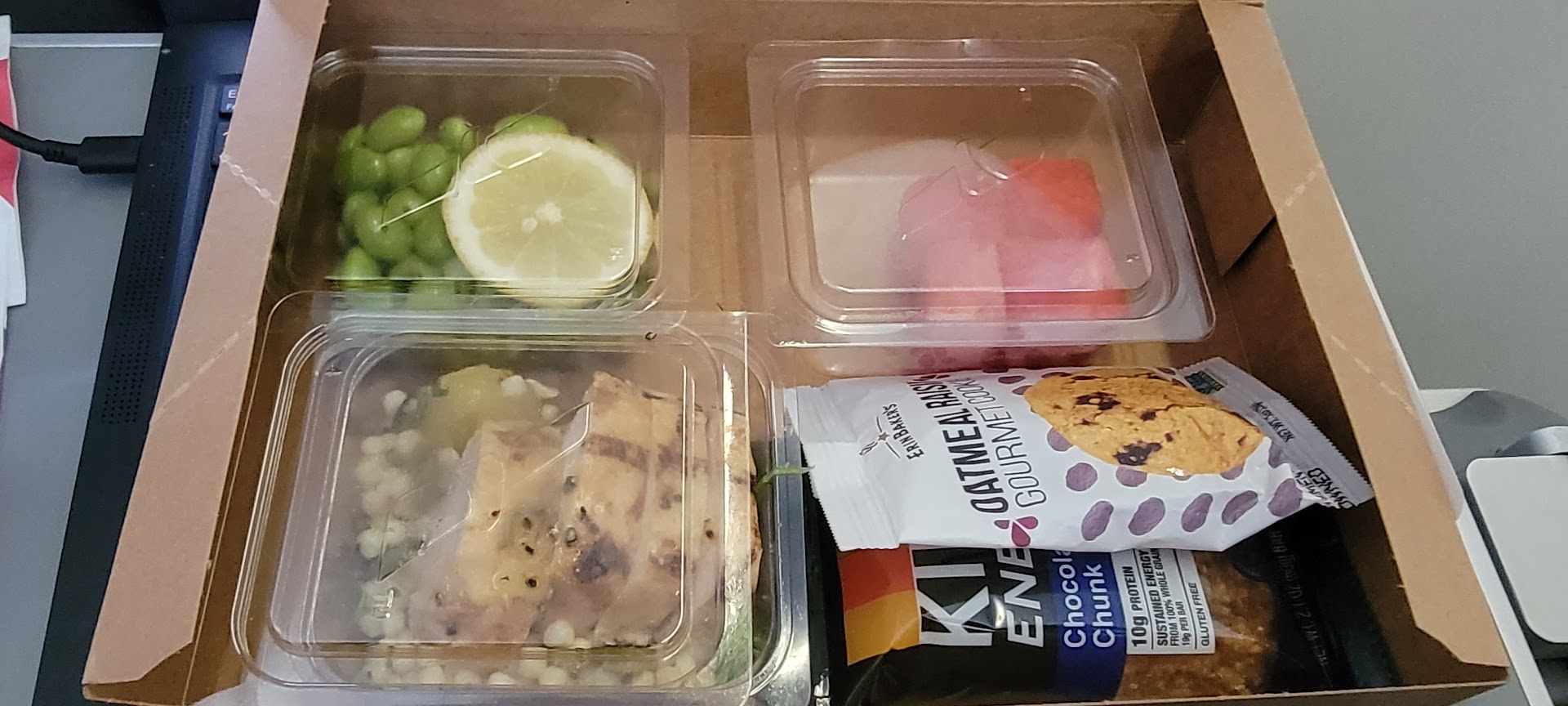
This is not to pick on American. I’ve been getting the same meals up front on United for years.
And earlier this year I tried the Delta Air Lines meatballs, which many have said is Delta’s best domestic first class meal choice and it was ‘meh’ at best.
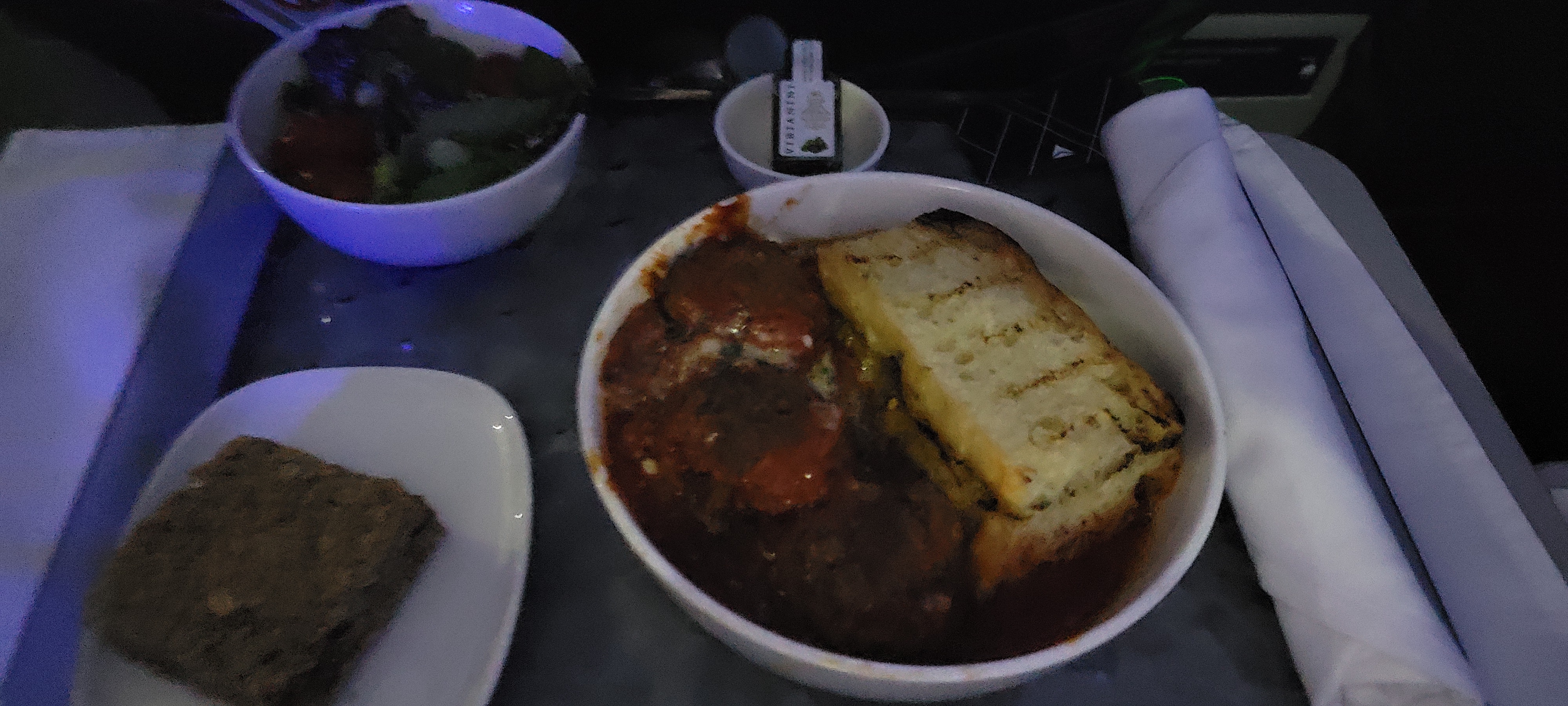
JetBlue does a nice job with its premium ‘Mint’ product, but that’s on a limited number of routes. For a true domestic first class offering, Alaska outperforms competitors by a lot. (Don’t even make me conjure of memories of United’s burger).
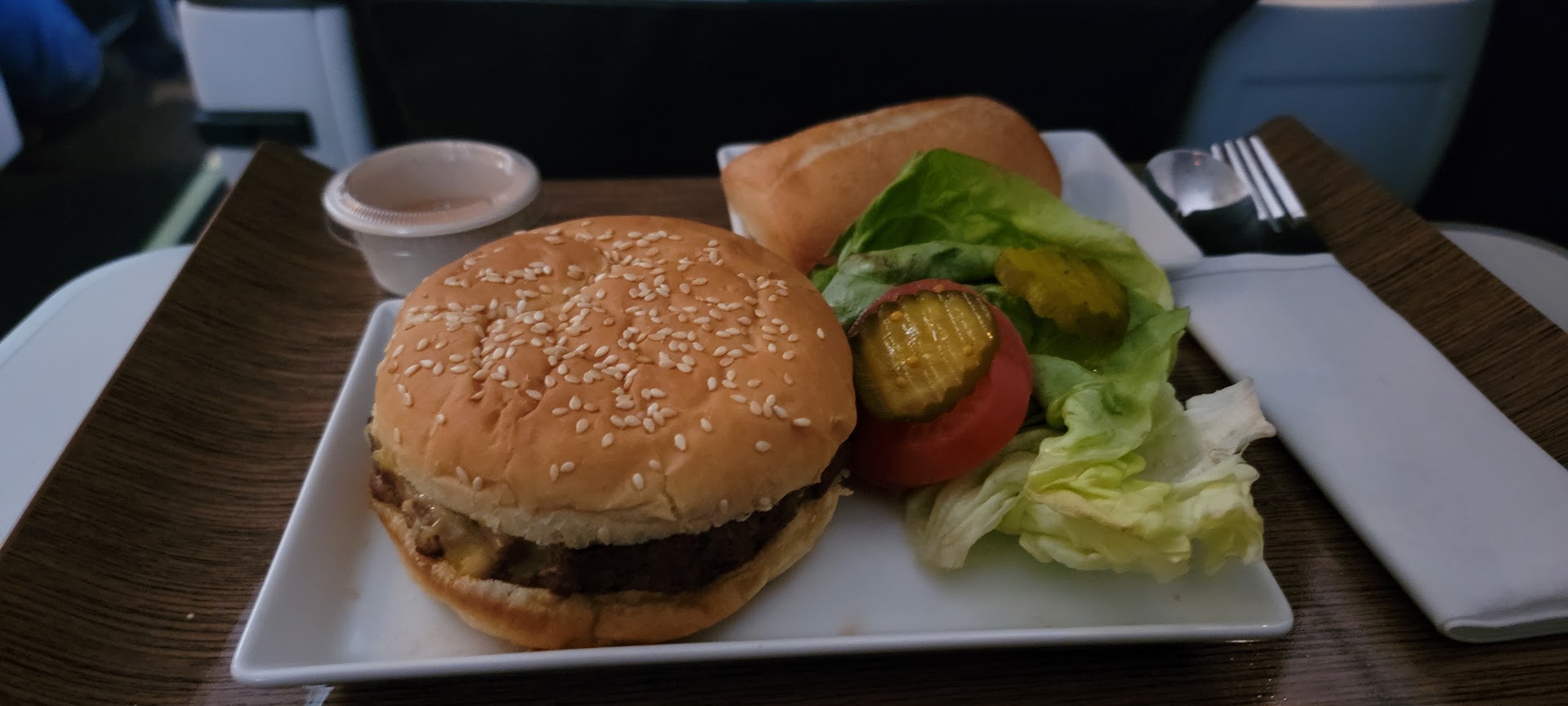
Alaska Airlines Burger
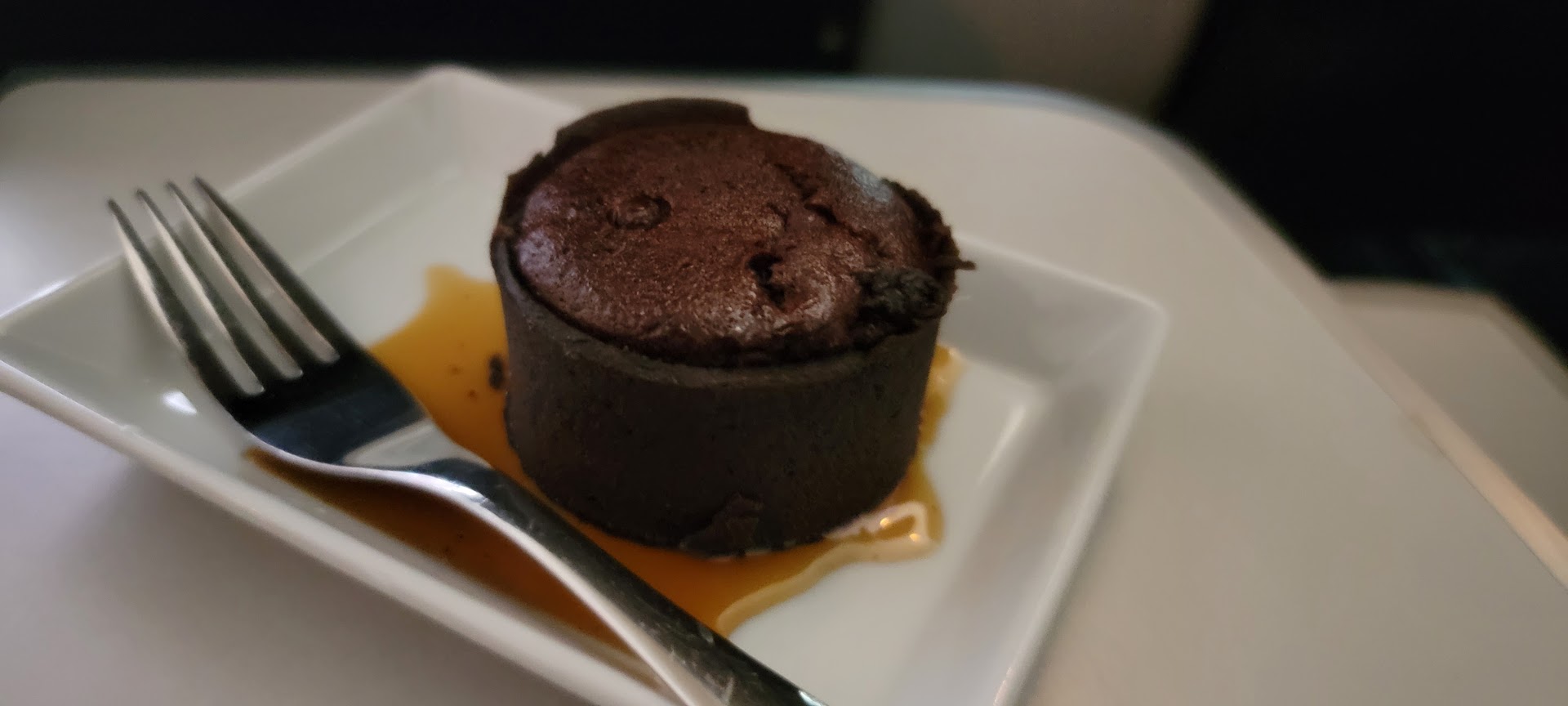
Alaska Airlines Dessert
U.S. airlines need to vary meals by region and direction; rotate those meals quarterly; and change them completely annually – at a minimum – or else you’re eating the same meals flight after flight, even on the same trip, and certainly week after week. It’s how things used to work even in the U.S. but carriers now keep meals around for ages.
By contrast, a reader passes along a photo of their Air France business class meal on the one-hour Paris to London Heathrow flight.
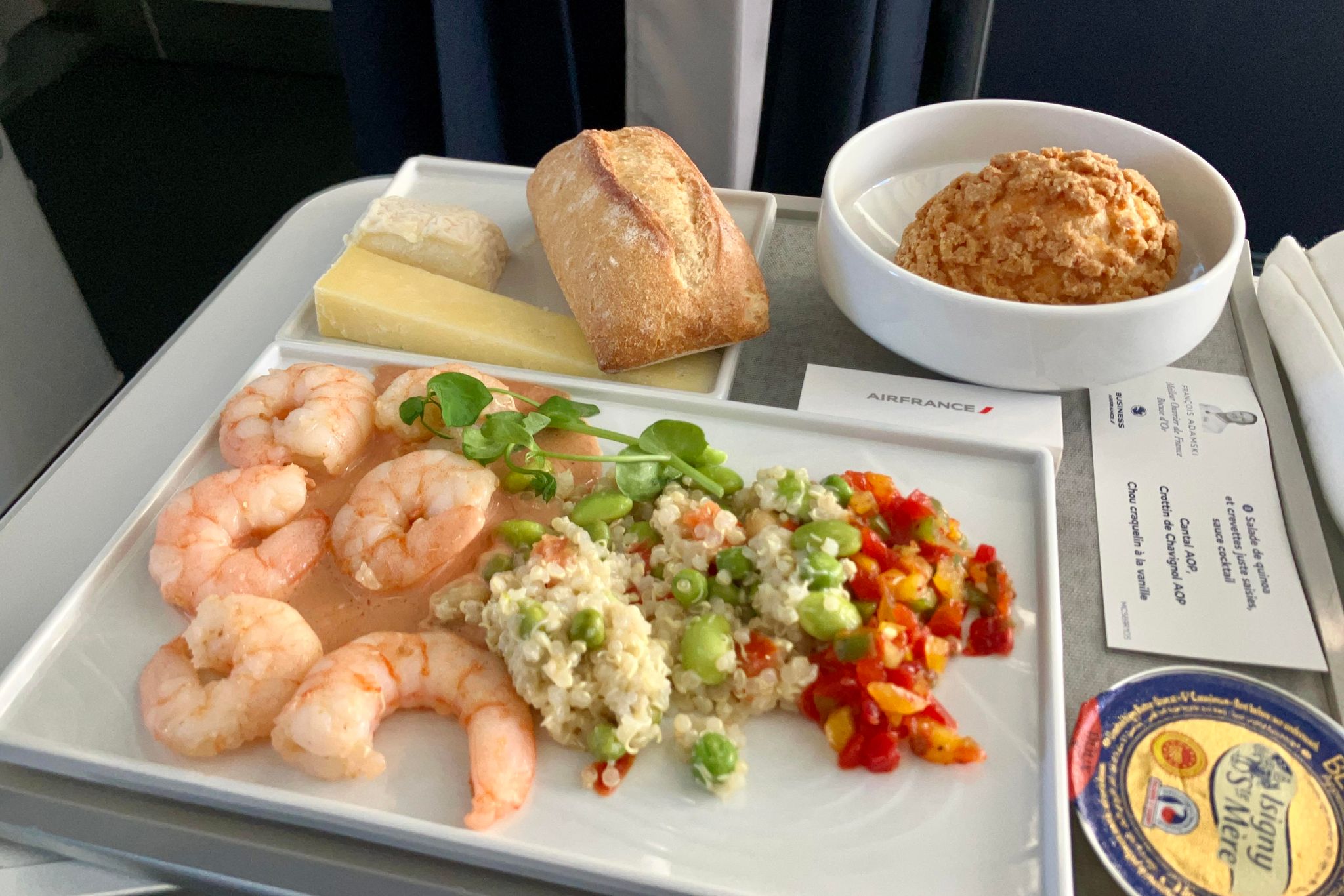
British Airways is hardly known for its food, but I’ve received these from British Airways on that same 216 mile route.
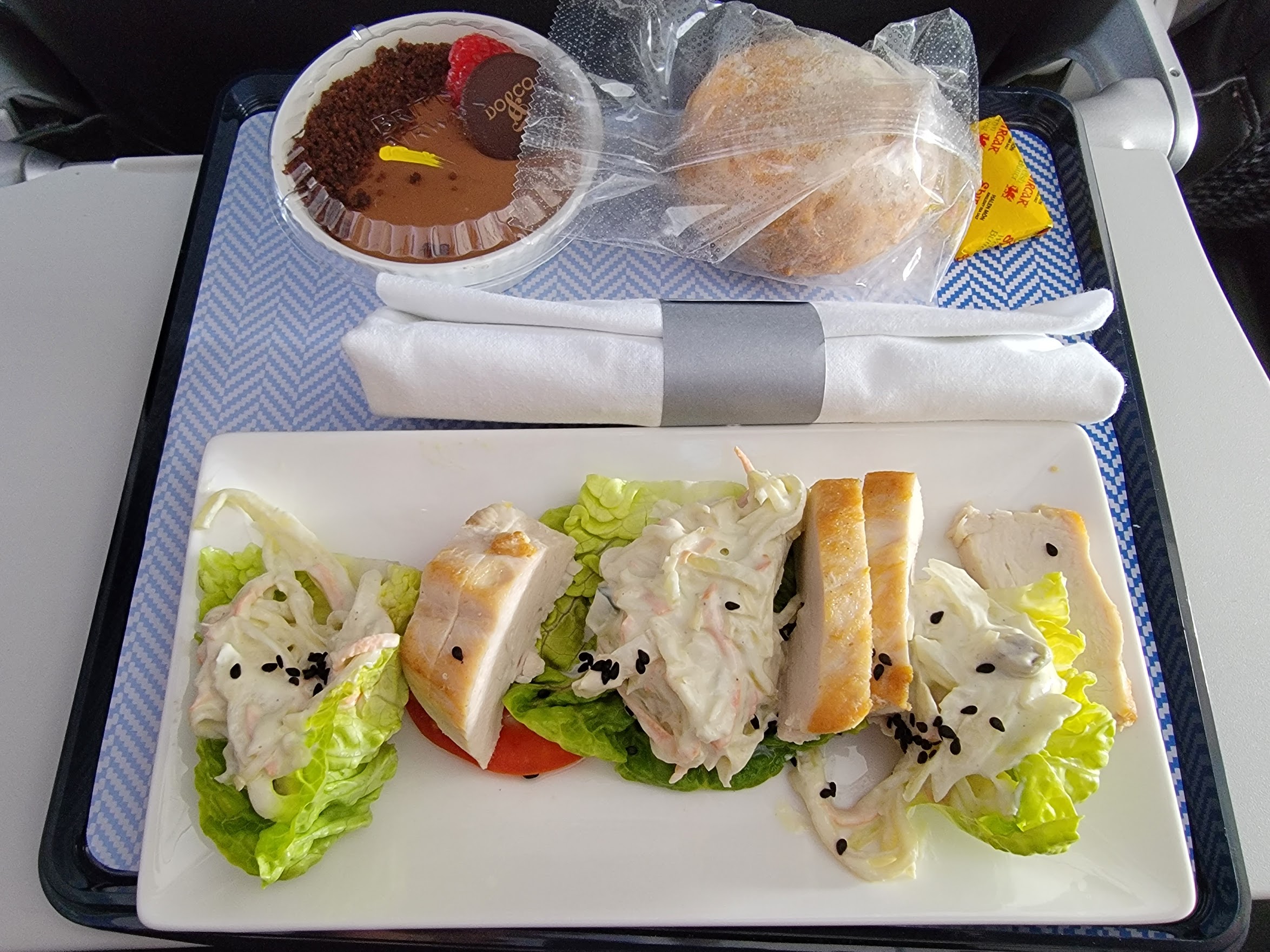
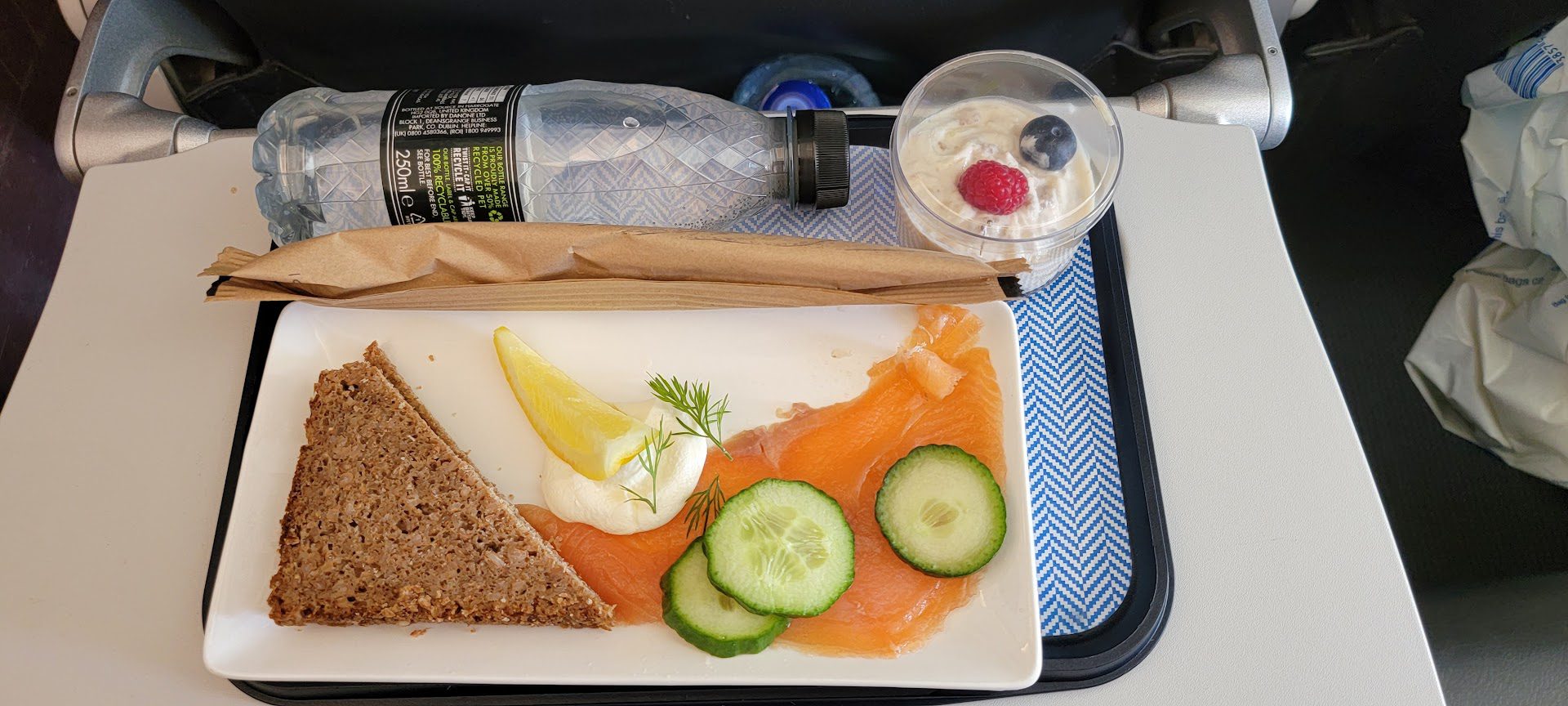
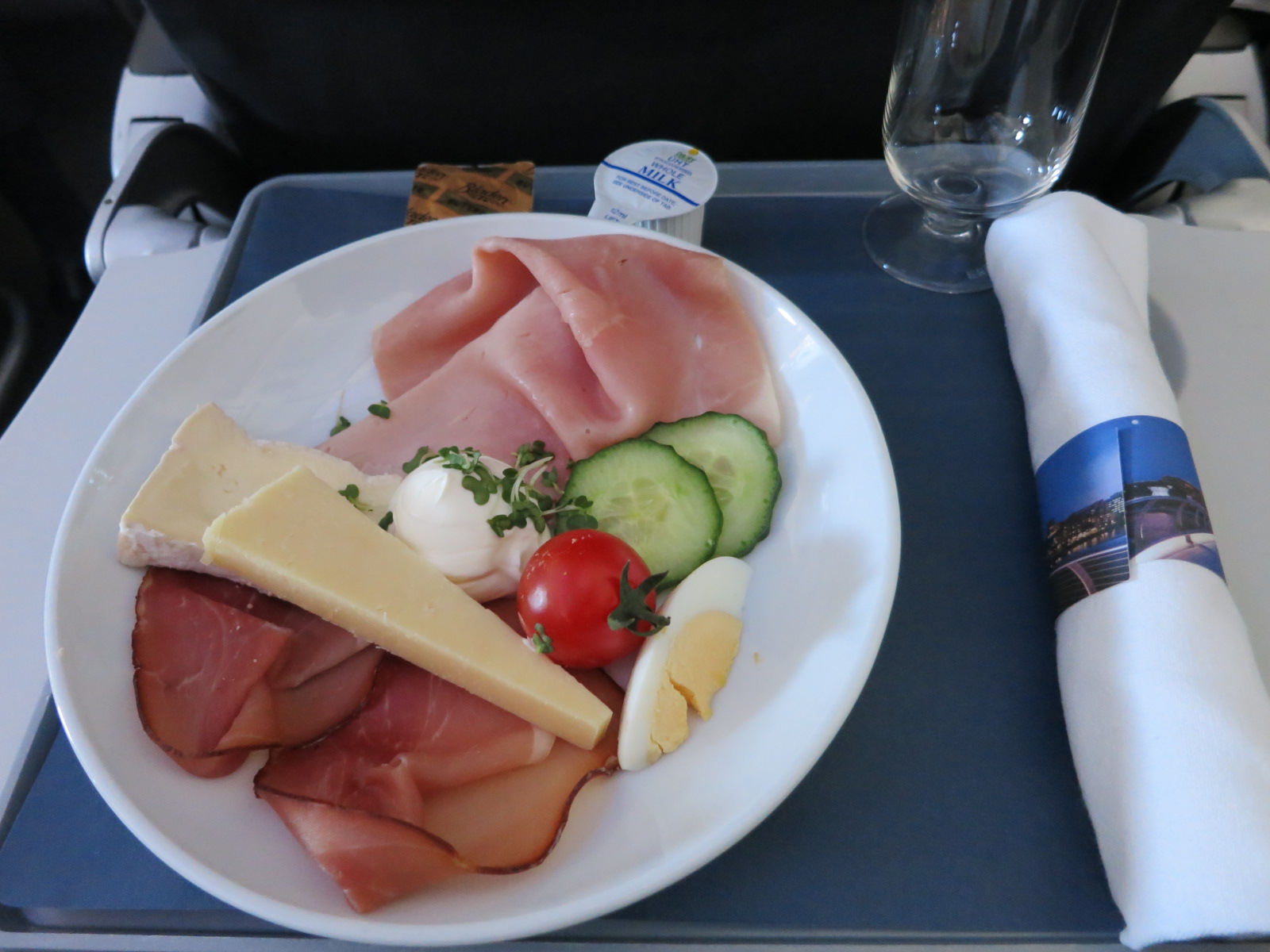
I even received a choice of meals from Qatar Airways on a 200 mile flight.

On a short two and a half hour Japan Airlines flight from Tokyo Narita to Shanghai, I’ve gotten a full meal. This one, for instance, was followed separately by an individual-sized container of Haagen Dazs ice cream.
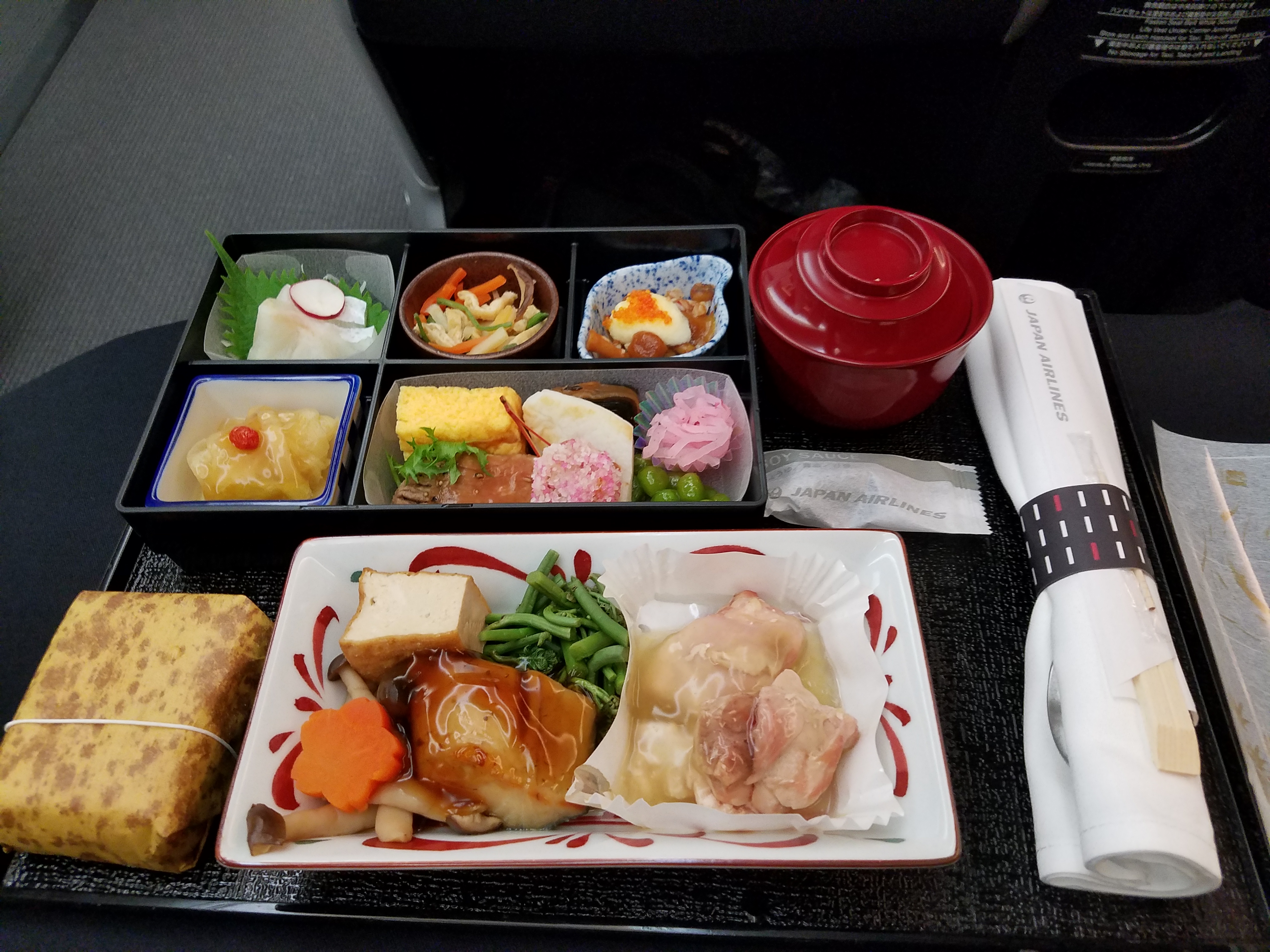
One of the best meals I’ve ever had on a plane was on a 1,037 mile Singapore Airlines flight. This seafood laksa was incredible.
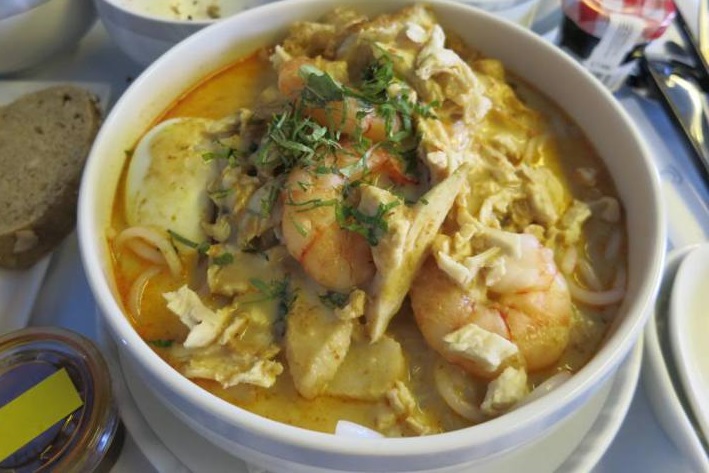
And how about a coursed meal that begins with satay on Malaysia Airlines in short-haul business class?
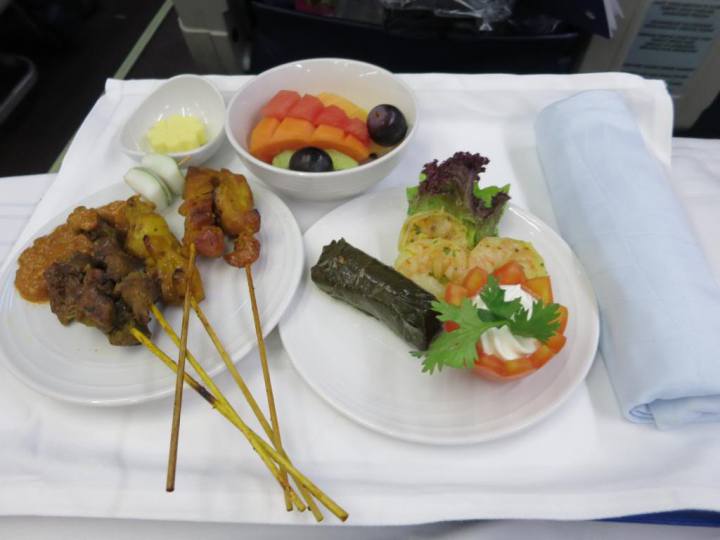
Airlines in Europe are offering more on one-hour flights than U.S. carriers provide on six and seven hour flights – to customers willing to pay for something better. That’s a combination of food spend and simply caring about the details of what you’re serving.
Airlines who simply check a box of needing a meal, rather than digging into the details not just of what’s being served but what the supply chain execution looks like and what the plating looks like aren’t going to get a decent product for their investment.
There’s really no excuse for what U.S. airlines serve their premium customers. If you tell me that U.S. airlines offer upgrades (increasingly few and far between and close to departure) then make better meals available by pre-order only, 72 hours in advance of travel. And sell better meals in coach! (Air Canada will sell leftover premium meals.) I’d even buy up for something decent rather than getting stuck with what’s currently served in front.
As a bonus, this would help to reduce lounge overcrowding since passengers would be able to get a meal that they can eat while on the plane. Airlines have been moving in the opposite direction, trying to feed passengers on the ground rather than in the air. But lounge overcrowding makes that unpleasant much of the time, and works best in dedicated business class lounges which are unavailable to most premium passengers flying domestically in any case.


Revenge is sweet. Just before boarding a Delta (LAX to NYC – nonstop) I purchased a huge, hot, smoking, pepperoni pizza and boarded with same.
The meal was lousy but the smell (pizza) wafting through the cabin brought tears to most people’s eyes.
Pizza isn’t THAT hard to produce. Toss in some free beer (Horizon Airlines!) and you’d have happy customers.
If possible I elect to fly on international carriers on all my flights to and from the US. It’s not just meals but I find the lounges significant better than those of US carrier’s.
@Jim Thurber
Nice!
As always BYOF.
Agree with Gary on all points re domestic FC. I also have had the same experience with Lufthansa and SWISS of tasty attractive food for even 50 min flights.
Commenting this just to be nit picky because like a true geek, I love these details, but the longest current US domestic flight is Boston to Honolulu, clocking in at 5,095 miles. This is roughly as long as Seoul to Sydney (5,164 miles) In economy, Hawaiian is currently serving scrambled eggs, bacon, and a small veggie sandwich later.
I can’t find what Delta plans on serving on the route.
Airlines just keep finding excuses for not serving meals as they once did. They used to boast about chefs who put these meals together. (Don’t want to eat at their restaurants.) It’s all about profit. And by the way, how much smaller could the tray tables and food trays get!
But European business class has the same seats as coach – the middle seat is often blocked, but the leg room is much less than US airlines first class.
Given a choice – legroom or decent food – I’ll take the legroom.
I’ve actually enjoyed domestic first class meals, mostly on United & Alaska. Certainly no worse than on many intra Europe and Asia. The examples shown here, I think, are exceptions. In fact, the worst meals I’ve had were on some intra-China and intra-Europe flight, but I forget the carriers.
I don’t mind the boxes on the Regional Jet flights because I think they are in general much more edible than mainline First meals. Fire was harnessed by humanity a long time ago. Heat does not impress me. I, in general, actually prefer domestic First on Regional Jet flights for AA because I love the seats with no one next to you.
My best airline meal ever was a Delta One hamburger – on the ground in Goose Bay on what was supposed to be LHR-MSP but lost an Engine over the Atlantic and diverted. May not have been great meal, but the context made it great.
We were on the ground for hours – in the winter – as a plane was sent from ATL and stopped to pick up a crew at JFK. By the time we swapped planes, the rain had turned into sleet and freezing rain and we shuffled across the tarmac. I think it was seven hours total delay.
Notice foreign carriers don’t flood their meals with cream or cheese sauces. Americans I guess expect everything has to be with cheese, cream or mayo.
@Jim
A pizza party upfront would be a perfect, easy and cost effective way to surprise and delight customers. It would not be hard at all to have a few pizzas delivered and kept warm for a couple of hours. It’s a shame that US airlines have just stopped trying.
The difference between US lounges and foreign lounges ( especially in Asia) is remarkable. I fly to SE Asia frequently and never try to take a US based Airline. Singapore, JAL, ANA, Asiana, Cathay Pacific , EVA, Korean are all far superior to any US airline in they’re service and did product offerings.
I’m pretty sure the mindset of US airlines is “if the first class cabin is full, we have to be doing something right”.
Gary – why are you so fixated on food? Every day there is either something about airline food or, god forbid, a “failure” related to a “free” breakfast. A flight is to get you where you are going. It isn’t fine dining and you, like most people, can certainly go a few hours without stuffing your face. So sad!
Totally agree – no excuse at all and it’s costing them money via fewer premium bookings, especially as more discretionary dollars are used for premium cabin vs those under corp travel cabin restrictions
We just returned from a four segment trip on American, PHX-MIA-GEE; SKB-MIA-PHX. On the first three flights the food was edible but that’s all, but on the almost 5 hour MIA-PHX leg all that was served was a choice of bags of chips or peanuts. American you should be ashamed!
“There’s really no excuse for what U.S. airlines serve their premium customers.” That single sentence from Gary’s post says everything that (sadly) needs to be said! I guess we can take some small solace from the fact that none of these forgettable, regrettable U.S. first class (?) meals contained either maggots or blades (both of which have been widely reported on this website to have been served on airlines recently). I hope U.S. airlines are reading and embarrassed by this comparison. Distinguish your airline — not by doing something extraordinary; rather by simply doing what foreign alliance partners already do — instead of joining the race to the bottom.
While I am not often a premium cabin flyer, every time I do fly first on a US carrier I am amazed at how poor the food is. Additionally seeing an international United menu where every meal choice has cheese in it, really? The food, the menu scheduling are, and have been for a long time inferior to international carriers.
The same applies to coach. I flew a three hour ATH-AMS flight on KLM. Coach passengers received a sandwich after takeoff and then a snack right before arrival. I also flew Lift, a South African LCC, from CPT-JNB and received a chocolate filled croissant for breakfast. When even a third world LCC puts US airlines to shame with their food offerings, it is sad.
So true! Over the past year, JFK-CDG one with Delta and the other with Air France…. Meals were night and day! To say the least, in Air France I had good croissants while Delta’s “breakfast” was a hard, cold egg “calzone” in a cardboard box.
International carriers are government subsidized and have a much more flexible cost structure than US based Airlines. This allows international carriers to offer better amenities and also better airfare out of their home countries.
BA now uses DO&CO, which is fantastic. I had a tea, finger sandwiches and scones lunch on an intra-Europe 1.5 hour flight last week that was honestly good enough that I’d buy it on the ground. It shows it can be done. Alaska (and before that Virgin America) probably has the best food in the US, but the rest of the US airlines have decided they don’t need to provide decent food or service to sell their F tickets, so don’t care. With loyalty dead, I’m not so sure about that – I definitely factor soft product into making my decisions- but it is what it is.
The US domestic routes get the seat better than short haul BA, AF etc which just block a middle seat
We flew LHR DUB and the FA staff moved the curtain from row 7 where I was to row 6 to separate the riff raff (us) from the First Class
The meals may be better but the seat is not.
The ones who get both right and better are QR, EY and EK on the short haul routes as well as SQ, JAL etc
The EU carriers presentation and meals are better but nothing else
I love reading these blogs about the shit service on U. S. airlines. Seems like every American brags about how everything is better in States, compared to Europe. What a joke.
I am American who retired in Malta almost six years ago. My wife is a Finn, so her country pays for all our medical care. YES. FREE. Our bills are lower by 40%. No property tax. Our condo assoc. Dues is $300/year, as to our last one States was $800/month. Education in Western Europe University is free.
And when you actually add in all the extras Americans have to pay for retirement, taxes are actually lower in Europe. Not to mention 5 week’s vacation.
Food on LH biz class is better than any first or biz class in States. That always includes full meals on flights as short as 2 hours.
And the best thing, the LH crews are far superior to those in States. Safety first, but still full service. Take that AA.
OH, fights on planes are not common like in States. Maybe you pass regulations allowing foreign airlines to operate in States. No one in Europe would ever fly on an American company in Europe.
I’ll say this slowly and loudly before my daddy opines on how the world’s #1 PREMIUM airline puts everyone else to shame:
IT’S ALL ABOUT THE SHAREHOLDERS! SCREW THE CUSTOMERS!!
I travel back and forth to the Middle East regularly. The meals on Qatar and Emirates are well know. Etihad is not quite the match. But on my early May trip from Istanbul to Beirut on Turkish (my first time with them) I could not believe how much food (and very well prepared) was on the tray presented to me. And to top that off, my flight from Beirut to Amman which is a 40 minute flight I was served a 3 course meal on a Royal Jordanian Embraer with a choice of either Euro or Middle Eastern with an extensive wine list to boot. Sourced no less from Beirut where the right things can be difficult to be had.
What is it with these American carriers and the outright garbage they serve ?!
@Gregg – U.S. airlines are heavily subsidized. But is your contention that British Airways is taking, say, its privileged position at Heathrow to… fund Club Europe catering? In what way is Japan Airlines more subsidized than American Airlines, and why does this affect catering?
I dare to say that the coach class meals I have had on Asian airlines (EVA, Korean, Singapore, Asiana) are better than first class meals on most USA airline flights that I have seen reports on lately.
One of the best airline meals I ever had was on AF Business AMS-CDG. On a late plane. After going to the KLM lounge. Followed by a run through the airport and on to CDG-ORD Biz. Now that was a meal! Still kicking myself for not grabbing a Chartreuse minibottle, but the wine selection was too good.
US airline food is sometimes okay, but after managing to use a SWU on an AA MUC-CLT flight, the food was so bad in business (completely inedible, no sauce was going to save that chicken) I decided chasing SWUs was a fool’s errand and downgraded to PlatPro. I’ll redirect the spending elsewhere and fly any other OneWorld airline if I can. Sometime you get what you pay (or don’t pay) for. And free ain’t what it’s cracked up to be.
Gary, this is one of your better stories on an often ignored, but a topic requiring far more coverage.
Frankly, the quality of food service on U.S. carriers has diminished as the accountant-types took over. Of course, strikes, bankruptcies, and mergers only exacerbated the financial condition of the carriers. Yet, the strict control over food costs only emulates how nursing homes operate to maximize their profits; nobody in our carriers gives a damn.
As American has sunk to new lows for domestic FC, and United is just a notch better, I avoid them whenever possible out of ORD. I found better service and food in Delta F.C., e.g., 717s ORD-LGA.
But no U.S. carrier can compare to Lufthansa in B.C., especially flying out of Germany. I even enjoyed a full lunch just between Frankfort-Geneva!
Just as the Board should be accountable for poor decisions and accounting shortcomings, so too should the Board be held liable for the pathetic, inferior food served aboard. But what if the selected Board doesn’t question the rote approach to finances and food service?
This is why I extol visiting supermarkets before flights. It works better when the airport has ’em (so … nowhere in the United States), but I always get a couple of snacks before a long-haul.
Even for short-hauls I have a protein bar/empty bottle with packets of lemon salt, to prepare for delays/cancellations. In countries where those things aren’t easily obtained, I still take a bite and an empty container.
Never found a reason to complain about crowded lounges, but always find that those who are rejected from entering — i.e. prevented from further adding to the crowds — can easily find alternative places to have a meal/sit.
FWIW, I just flew economy on Solomon Airlines from Honiara, Solomon Islands to Port Vila, Vanuatu. Flight time 1:45 hr flight. Lunch was a choice of chicken or lamb with rice, bread roll, butter, dessert and small chocolate. Free beer and wine available.
Not bad for an under 2 hour flight, in economy, in the South Pacific.
When I fly domestic and even international on US carriers it seems a good portion of the travelers up front are on upgrades. Asian carriers are much more stingy with upgrades and most pax up front have paid for it. Might that be a reason for the terrible food (and service) on US carriers’ business and first class offerings?
I bought roundtrip biz class from LAX to London and could choose between BA or American and went with American because it was a 1-2-1 setup (BA has that crazy 2-4-2 setup or whatever at the time I wanted). I really wish I picked BA. The meal on the flight from LHR to LAX was so bad in business class that I asked if I could get an economy meal instead — they didn’t let me, though, so I just ate the bread and the salad.
I am in Taipei. Route: BKK to HK, HK to TPE on Cathay. The BKK leg, about 3 hours, has lay flat seats. The wine list, service and meals are incredible. In HK, off the the Pier at gate 65. Anyone knows this lounge is as good or better than a top notch American restaurant. Incredible. The Taipei leg is 1:50. That business class is in the newer Airbus setup with paired 2:2:2 encased seats. Great for couples and great for work. Incredible meal, great food and drink choices, and for those who prefer champagne, it is that. Cathay lounge in BKK is beautiful and the new lounge in Taipei is spectacular. These are civilized, regal and calming. I NEVER fly domestic carriers if I leave American soil, and I fly Cathay, Singapore and KAL to Asia. Of the 3, KAL is “budget feel”, yet their in flight service in impressive. You aren’t stuffed like a mushroom in Economy. There is a reason why Americans are so angry. Our airports are also an embarrassment. Asia is stunning compared to America and Europe.
I agree that Alaska does the best job of US carriers on both the food being interesting and flavorful and well-presented. That said, I’ve noticed that portion size is an issue (e.g., tiny little salads) considering some of the segment lengths AS flies by nature of its SEA hub. And even Alaska’s service has declined in terms of presentation–for example, SEA-DCA used to be a coursed meal (salad, appetizer; then mains; then dessert) and how it’s a single tray service (sometimes dessert gets delivered separately; depends on the FA).
Huge complaint about AA is this idea that FC flyers now get a single beverage. FAs do the initial beverage service and serve the meal after and, in most cases, it’s begging the FA to get a refill on water, much less the FA offering a glass of wine with dinner. I think I’ve said it before, but I go back to how the service flow fails to hardwire gestures customers would appreciate. Old AA, meals were offered from the cart in the aisle (where beverages were right there for the FA to offer) and the tray had, as part of the catering set-up, two glasses–one water, one wine–prompting the FA to ask. Now the trays don’t have the glasses and are run from the galley, and with most FAs it just feels like a rush to get the tray placed on the tray table as soon as possible.
Most us carriers suck with catering
Sometimes you get lucky and it’s actually good
Like winning the lottery as most of it is crap
I just flew coach Chicago to Madrid and back on Iberia. Actually had really good food on both flights. Nothing fancy –
just basic good food. I don’t understand why US airlines can’t get this right.
It might be a nice comparison to now compare US airline CEO compensation to the international carriers. I’d be willing to be that CEO compensation is inversely proportion to food quality.
I switched from Delta to Alaska after their medallion devaluation last year and the catering is reason enough not to fly Delta again. I fly out of Lihue and Deltas meal service consisted of a box with a sandwich, chips and cookie in First. Alaska still courses their meal service, starts with warm nuts, appetizer& entree than dessert. The lemon Meringue tart on last weeks flight was better than any airline dessert I’ve had with the exception of a possible tie with Air France.
So, basically, the debate comes down to deciding which POS is more appealing than another POS. Solution? Don’t eat any of it, it’s all garbage.
Elites are served a lot of bad food in America in a lot of places I guess they tolerate it. Nobody should ever book a domestic flight based on the quality of the onboard food, and very few do. I think this explains why US airline food isn’t great. This makes near zero difference to me, as I (and most other very frequent flyers) can usually get comparable food, for free, at the airport.
As a retired airline employee that used to fly LAX to Australia , Singapore and India I always avoided interline US carriers like the plaque. The first or business class provided on DL, UA , AA is equal to that of international economy class ( maybe). Singapore Airlines is among the best the FA are still focused on providing exceptional service. All US carriers have lost the focus pre and post pandemic for the big three AA, DL, UA its now all about profits to they forgot customer service and inflight service a long time ago. Do not expect many changes in the near future.
Even Aeroflot offers a tuna sub on a 2-hr domestic flight (economy) that was far more palatable than most of the slop served in USA F class.
Basicallly it boils down to “we don’t care we don’t have to” mentality, with a dash of Elliott hedge fund overseers who want to nickle and dime every olive from your plate.
Sadly all US businesses thrive on greed and airlines are top of the list!
I had excellent meals recently on both Norse Atlantic and BA.
Food is generally lousy and overpriced in North America, so no exception on the airlines. It is just part of the culture.
On the other hand I recently took a BA flight from LGW to Crete and they had a very nice sandwich menu. Unfortunately they didn’t have any sandwiches on board.
Well,world’s most disgusting people in Satan’s own country get what they are entitled to
Dreck!
For awhile, US airlines used Covid as an excuse. No longer valid. They all need to up their game. It does seem like they just think whatever is passable is good. My girlfriend and I flew First from DFW to Cabo. The meal was decent. But not memorable.
Flying domestic within the USA is like being on a MegaBus. It’s really sad how USA airlines fail their passengers in so many ways and the food is an easy fix.
I agree with all the points, short trips within Europe and abroad you always gets a decent meal and presentation. Only exception, was when I flew Delta to Rio and their Business Class product is bad (food was barely edible)
I’ve always wondered why airlines like United, like to fly their older planes from Chicago to Honolulu direct (8 hours) and yet they don’t serve food, unless you’re in first class. Even the first class product on that route is subpar as you get a recliner seats. I get it’s not a competitive route, but it’s a terrible experience.
If a domestic carrier wanted to win more business and more loyal customers start with improving the food experience and the in flight experience. Treat all your customers like they are VIPs even if they don’t pay for a premium fare. Like the saying goes the way to a man’s heart is through food.
I agree with Rob H. I’ve almost entirely stopped flying domestic; if I can’t drive there or have a good flight experience, it takes a lot to convince me that it’s worth going there. Even in FC, domestic flights have become too close to one of Dante’s levels of Hell. And the food does, indeed, matter.
The lounges have become more important than ever, due to the frequent delays & layovers; on a recent long layover at CDG we had free wifi, lunch & showers. Meals, meanwhile, do matter to us as we fly most often from California to France. Going next to Portugal & flying AF again, due to both product quality & flight choices. And we’re paying, not using points.
The idea of being able to preorder better quality meals for passengers that are actually paying to seat in a premium cabin is reasonable. Then the passengers doesn’t show up and airline caters 100% meal count , so how do you solve that ?
I can’t comprehend why somebody would need a meal on a 200 miles flight ?
Airlines are loathe to spend any money on those who receive free upgrades, so for many years it was understandable that the soft product on domestic first sucked. Now that the vast majority are paid tickets, the disconnect between premium expectations and reality is more problematic. At least DL seems to understand that their first class cabin is selling more than just a big front seat.
@Eric what if the 200 mile flight leaves at 11:45? Flight time may only be 25 minutes, but with taxi/takeoff you are probably looking at a boarding time of 11 and an arrival time of 1. What if this flight were a connection? Plenty of reasons why it’d be more convenient to eat en route.
The emphasis on airline food still perplexes me. If eating is so important, I tend to eat prior to travel or buy something at the airport or grab something in a lounge. Airline food has always been the punchline of jokes. Now that more and more airlines are upping their food game, one would think that the US airlines would take note and at least try to offer something other than what often looks like slop. They don’t have to because Americans are a captive audience and put up with below par service, food.
The only thing ‘premium’ in US domestic travel (and often, international) is the carrier puff-piece promotion. They set expectations on which they don’t even try to follow through.
I’ve flown economy across the world and the U.S. airlines are the absolute worst. Even when you are traveling on a major airline like Delta or United, you get no hot food in domestic no matter how long the flight is. All you get are some worn out pretzels and drinks to choose from.
The U.S. is just so far behind that it’s a shame. Compare this with other carries like Thai, Air India, Garuda Indonesia etc and you get perfect and tasty hot meals even on the shortest of flights.
Overall the behavior of flight attendants is very indifferent and rude as well in the U.S.
No wonder there are so many videos on YouTube trashing our entire aviation system. We are now a laughing stock to the world.